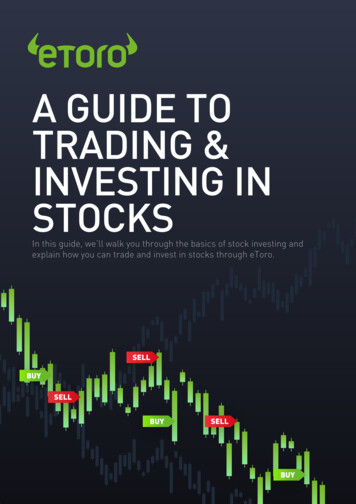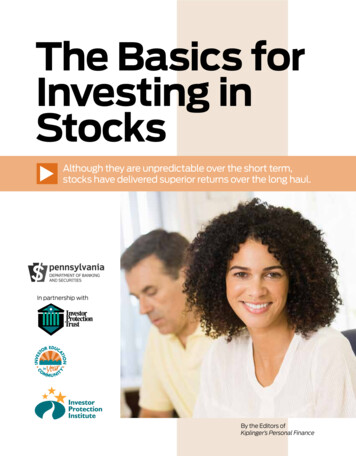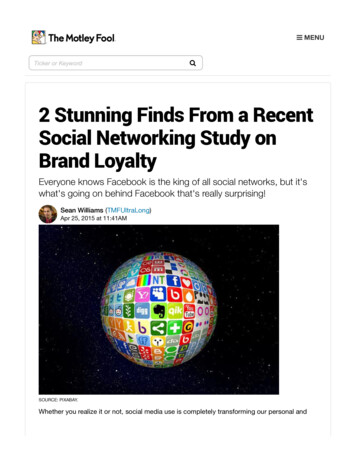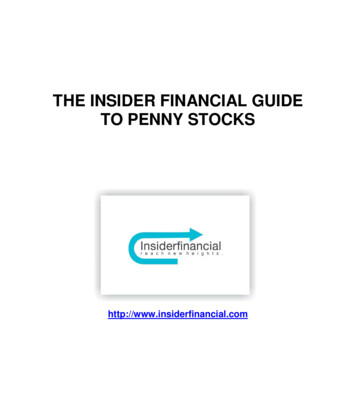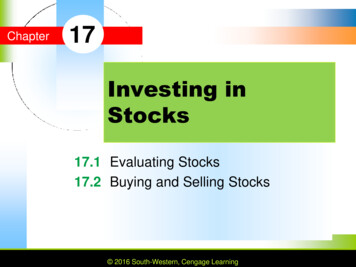
Transcription
Chapter17Investing inStocks17.1 Evaluating Stocks17.2 Buying and Selling Stocks20102016South-Western,CengageLearning 2016South-Western,CengageLearning
Lesson 17.1Evaluating StocksLearning ObjectivesLO 1-1 Describe features of stock and typesof stocks.LO 1-2 Explain how to value a stock anddecide a fair price to pay for a stockpurchase.Chapter 17 LearningLearning SLIDE 2
Owning Stock A public corporation is a company whosestock is traded openly on stock markets. People who own shares of stock are calledstockholders, or shareholders, of thecorporation. Two ways to profit from owning stock: Dividends are money paid to stockholders from thecorporation’s earnings (profits). Capital gain is an increase in the value of the stockover time.Chapter 17 LearningLearning SLIDE 3
Common Stock Common stock represents a type ofstock that pays a variable dividend andgives the holder voting rights. A proxy is a stockholder’s writtenauthorization to transfer his or her votingrights to someone else, usually acompany manager.Chapter 17 LearningLearning SLIDE 4
Preferred Stock Preferred stock represents a type of stockthat pays a fixed dividend but has no votingrights. Preferred stockholders earn the stateddividend, regardless of how the company isdoing. Preferred stock is less risky than common stock. Dividends on preferred stock may be lower than thedividends the common stockholders would earn, ifthe company is thriving over time.Chapter 17 LearningLearning SLIDE 5
Types of Stock Investments Income stocks Growth stocks Blue chip stocks Emerging stocks Cyclical stocks Defensive stocksChapter 17 LearningLearning SLIDE 6
Income Stocks and Growth Stocks Income stocks are stocks that have aconsistent history of paying highdividends. Growth stocks are stocks incorporations that reinvest their profits intothe business so that it can grow.Chapter 17 LearningLearning SLIDE 7
Emerging Stocksand Blue Chip Stocks Emerging stocks are stocks in young,often small corporations that have higheroverall risk than stocks of companies thathave been successful for many years. Blue chip stocks are stocks of large,well-established corporations with a solidrecord of profitability.Chapter 17 LearningLearning SLIDE 8
Defensive Stocksand Cyclical Stocks A defensive stock, or non-cyclical stock,is one that remains stable and paysdividends during an economic decline. Cyclical stocks do well when theeconomy is stable or growing but oftendo poorly during recessions, when theeconomy slows down.Chapter 17 LearningLearning SLIDE 9
Valuing Stock The par value is an assigned dollarvalue given to each share of stock. Market value is the price for which thestock is bought and sold in themarketplace.Chapter 17 LearningLearning SLIDE 10
Stock Price Factors that affect price include: The company’s earning power Interest rates The market Earnings per share Stock market conditionsChapter 17 LearningLearning SLIDE 11
Return on Investment You should consider both dividends and anyincrease in the price of the stock (capital gain)when computing the return on your investment. Your profit is the difference between what youpaid for the stock and what you sold it for, plusany dividends you earned. To compute the total costs, add anycommission you paid to the stockbroker to thepurchase price of the stock.Chapter 17 LearningLearning SLIDE 12
Stock Indexes A stock index is a benchmark thatinvestors use to judge the performance oftheir investments. Examples of commonly used indexesinclude: Dow Jones Industrial Average Standard & Poor’s 500 NASDAQ Composite IndexChapter 17 LearningLearning SLIDE 13
Lesson 17.2Buying and Selling StockLearning ObjectivesLO 2-1 Describe the channels involved inbuying and selling stocks.LO 2-2 Describe short-term and long-termstrategies for buying and selling stocks.LO 2-3 Explain how to read the stocklistings and stock indexes.Chapter 17 LearningLearning SLIDE 14
The Securities Market A securities exchange is a marketplacewhere brokers who are representinginvestors meet to buy and sell securities. The over-the-counter (OTC) market is anetwork of brokers who buy and sell thesecurities of corporations that are notlisted on a securities exchange.Chapter 17 LearningLearning SLIDE 15
Investing Strategies Short-term techniques Buy on margin Sell short Long-term techniques Buy and hold Dollar-cost averaging Direct investment Reinvesting dividendsChapter 17 LearningLearning SLIDE 16
Buy on Margin You can borrow money from your broker to buy stock ifyou open a margin account and sign a contract calleda margin agreement. Leverage is the use of borrowed money to buysecurities. When the market value of a margined stock decreasesup to 25% of the original purchase price, the investorwill receive a margin call from the broker. The investor must pledge additional cash or securitiesto serve as collateral for the loan.Chapter 17 LearningLearning SLIDE 17
Sell Short Short selling is selling stock borrowed from abroker that must be replaced at a later time. To sell short, you borrow a certain number ofshares from the broker. You then sell the borrowed stock, knowing thatyou must buy it back later and return it to thebroker. You are betting that the price will drop, so thatyou can buy it back at a lower price than yousold it for, thus making a profit.Chapter 17 LearningLearning SLIDE 18
Long-Term Investing Techniques Buy and hold Dollar-cost averaging Direct investment Reinvesting dividendsChapter 17 LearningLearning SLIDE 19
Buy and Hold Most investors consider stock purchases aslong-term investments. All stocks go up and down, but over a numberof years, the overall trend of nonspeculativestocks (stocks with a low degree of risk) ismoderately up. If you “buy and hold” stocks for many years,you can ride out the down times. When you are ready to sell years later, mostlikely your stock will have gained value. Many stocks pay dividends, so you are earningincome while you hold the stock.Chapter 17 LearningLearning SLIDE 20
Stock Split A stock split is an increase in the number ofoutstanding shares of a company’s stock. When a company increases its number of outstandingshares, it lowers the selling price in direct proportion. A stock split lowers the selling price of the stock,making the shares more affordable and encouraginginvestors to buy more. As investors buy more stock at the lower price, theshare price often rises. If you held the stock before the split, then this priceincrease makes your stock worth more.Chapter 17 LearningLearning SLIDE 21
Dollar-Cost Averaging The dollar-cost averaging techniqueinvolves the systematic purchase of anequal dollar amount of the same stock atregular intervals, regardless of shareprice. The result is usually a lower average costper share.Chapter 17 LearningLearning SLIDE 22
Direct Investment You can save money using directinvestment, or buying stock directly froma corporation. By buying directly, you avoid brokerage andother purchasing fees. You may also be able to obtain shares atprices lower than on open exchanges.Chapter 17 LearningLearning SLIDE 23
Reinvesting Dividends Dividend reinvestment means usingdividends previously earned on the stockto buy more shares. Buying stock this way avoids a broker feeand other costs that apply, such as taxes,when you receive cash dividends on thestock.Chapter 17 LearningLearning SLIDE 24
Reading the Stock ListingsChapter 17 LearningLearning SLIDE 25
Stock Progress ChartClosing Prices for 10 DaysTotalChange( or –)StockNames123456789101. 30.00 22. 0038.0003. Karbr 13 .134. 53.50 3.375. .50–1.50Chapter 17 LearningLearning SLIDE 26
Chapter 17 Emerging Stocks and Blue Chip Stocks Emerging stocks are stocks in young, often small corporations that have higher overall risk than stocks of companies that have been successful for many years. Blue chip stocks are stocks of large, well-established corporations with a solid record of profitability.


